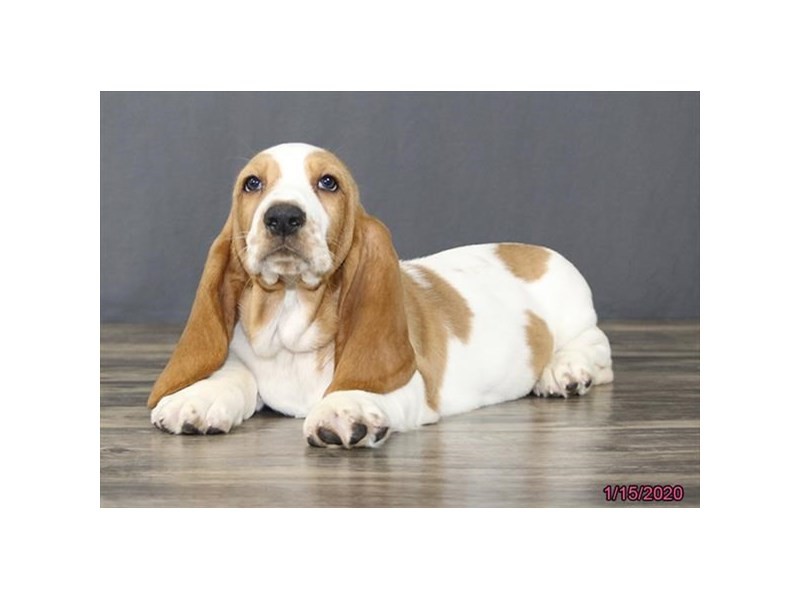
The lemon and white Basset Hound represents one of the recognized bi-color patterns within this beloved French breed. This unique coloration features a predominantly white coat accented by patches of soft lemon - a pale, diluted yellow shade that creates an elegant, understated appearance. While less common than the traditional tri-color pattern, lemon and white Basset Hounds possess the same endearing characteristics that define the breed: the distinctive droopy ears, sad eyes, and stocky build. This AKC-recognized color variation maintains all the hunting capabilities, friendly temperament, and lovable personality traits that have made Basset Hounds popular family companions since their development in France.
Lemon and White Basset Hound
Genetic Characteristics
The lemon and white color variation is produced by specific genetic factors affecting pigmentation. According to research, this bi-color pattern is controlled by the Extension gene, which regulates pigment distribution. The "lemon" presents as a light cream to pale yellow color combined with white markings.
Pattern Distribution
The lemon coloring typically appears on the back, face, and ears of the Basset Hound, while white markings are commonly found on the chest, legs, belly and tip of tail, as noted by breed experts. This is considered one of the standard bi-color patterns recognized by major kennel clubs, though it is less common than the traditional tri-color pattern. The lemon patches can vary in intensity from very pale to deeper golden hues while maintaining clear boundaries with the white portions.
Overview of Lemon and White Basset Hound Coloration
Breed Recognition Status
According to breed standards, the lemon and white combination is recognized as one of the official bi-color patterns for Basset Hounds. This coloration is accepted by major kennel clubs and breed registries as a standard variation, though it appears less frequently than tri-colored patterns.
Appearance Characteristics
While the previous section discussed pattern distribution broadly, this section focuses specifically on visual traits. As noted by breed experts, lemon and white Basset Hounds maintain the breed's distinctive physical features - droopy ears, sad eyes, and wrinkled foreheads - but with a softer, more subtle contrast between colors compared to other variations. The lemon patches create a gentler appearance while still highlighting the breed's characteristic facial features and body structure.
Physical Characteristics and Recognition Standards
Official Breed Standard Measurements
While maintaining the standard Basset Hound height requirement of under 15 inches, lemon and white specimens must meet specific AKC guidelines for bi-colored patterns. The lemon markings must show clear definition against white areas without any blending or mottling between colors. The breed standard requires these dogs to maintain the characteristic rectangular body shape with proper bone structure regardless of color variation.
Show Ring Presentation
Show requirements specify that lemon and white Basset Hounds must demonstrate distinct color separation between the lemon patches and white areas for optimal presentation. The lemon coloring should appear uniform in shade across all marked areas without fading or variations. While the previous sections covered pattern placement, show standards specifically focus on the quality and consistency of the coloring for competition purposes.
Lemon and White Basset Hound Rareness and Desirability
Population Frequency
While the previous sections covered pattern recognition and standards, this section focuses on prevalence. According to breed statistics, lemon and white is one of the rarer bi-color combinations in Basset Hounds, appearing less frequently than black and white or mahogany and white variations. The lighter coloring makes these dogs particularly striking and sought-after by enthusiasts.
Show Ring Impact
Though earlier sections discussed show standards, this section examines competitive implications. As noted by breed experts, the lemon and white coloration can provide enhanced visibility in show rings compared to darker-colored Bassets. The lighter coat helps judges better evaluate the breed's characteristic features like wrinkles and muscle definition during competitions, though color alone does not influence judging decisions.
Conclusion
The lemon and white Basset Hound represents a distinctive and recognized bi-color variation of the breed, characterized by pale yellow to cream-colored patches contrasting with white markings. This coloration is controlled by specific genetic factors and follows standardized pattern distributions, with lemon typically appearing on the back, face, and ears while white marks the chest, legs, belly and tail tip. Though less common than the traditional tri-color pattern, it is fully accepted by major kennel clubs as a standard variation.
The research indicates that this coloring pattern holds unique advantages in show settings due to enhanced visibility of the breed's characteristic features, though color alone does not impact judging. As one of the rarer bi-color combinations, lemon and white Basset Hounds maintain significant appeal among breed enthusiasts while still adhering to all standard physical requirements including height, structure, and proper color separation between patches. This distinctive appearance combines the breed's beloved physical traits with a softer, more subtle color contrast that highlights their characteristic features.